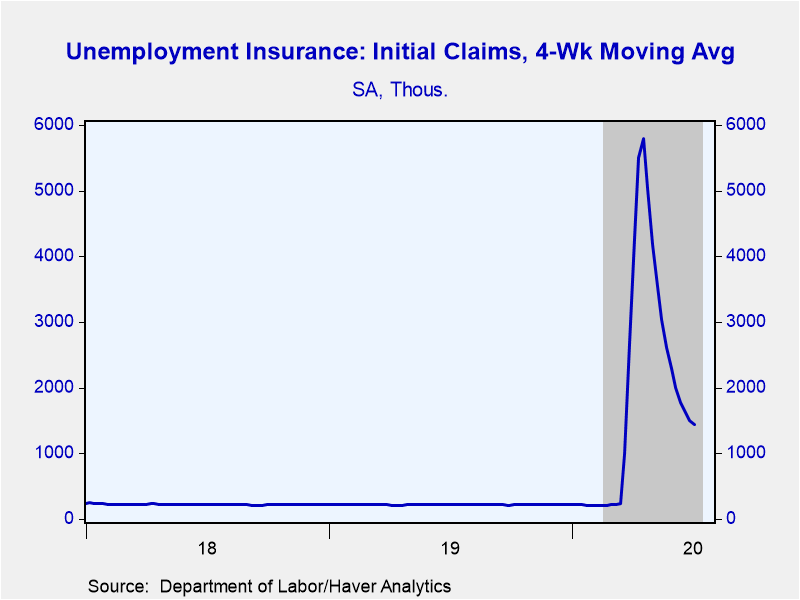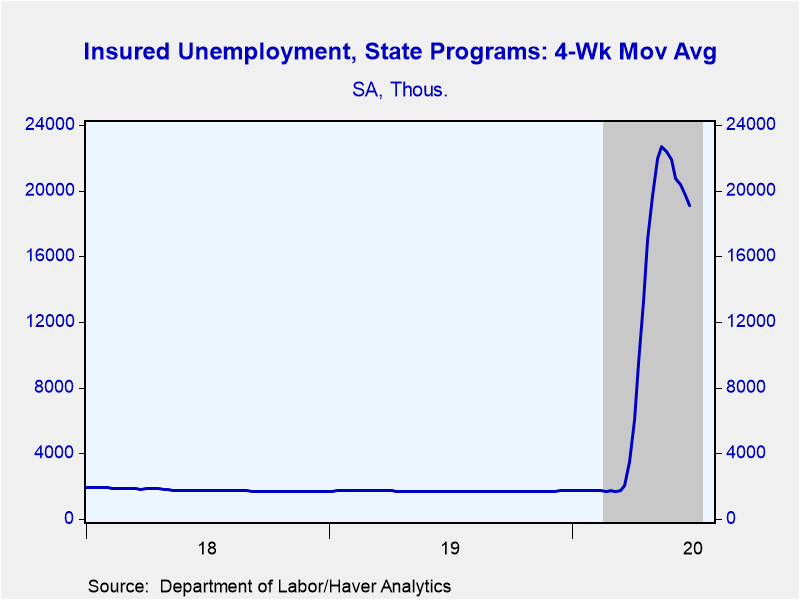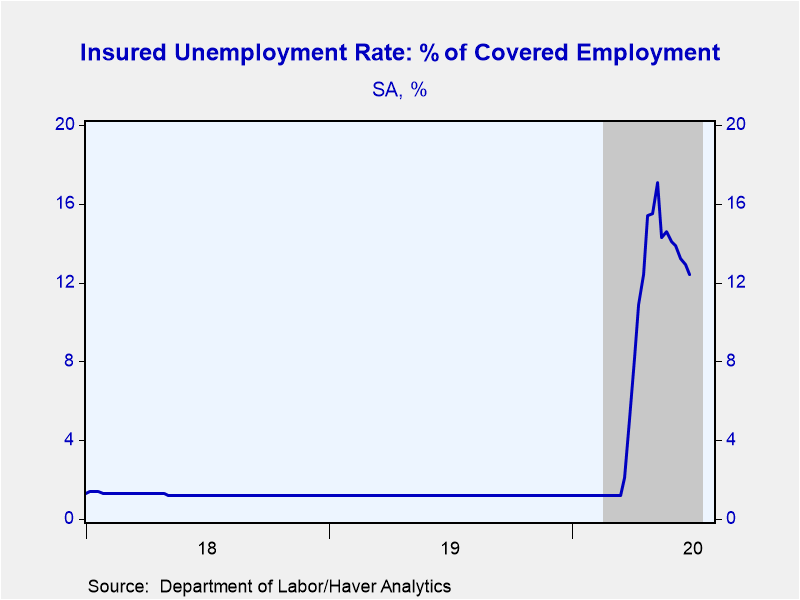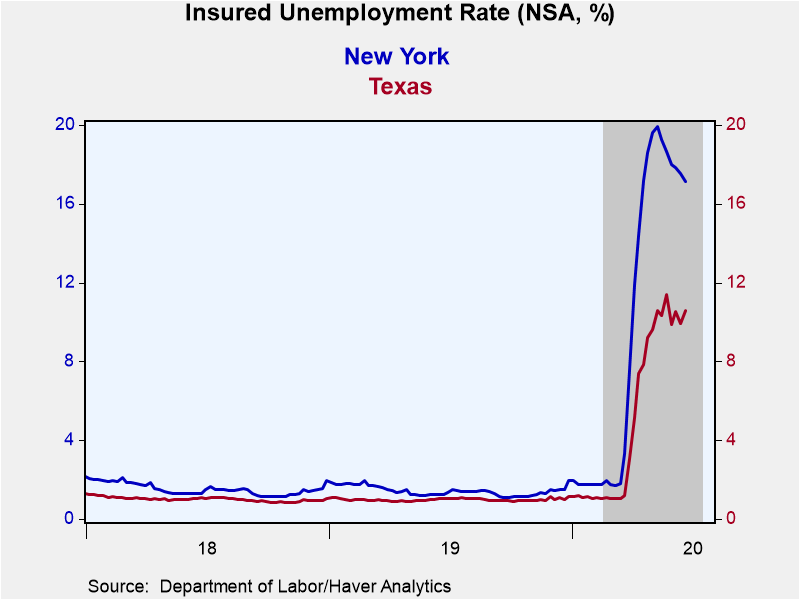 Global| Jul 09 2020
Global| Jul 09 2020U.S. Initial Claims for Unemployment Insurance Decline
by:Tom Moeller
|in:Economy in Brief
Summary
• State initial jobless claims fell to 1.314 million last week. • New applications for Federal Pandemic Unemployment Assistance rose to 1.039 million. • Continuing claims for jobless insurance and the insured jobless rate eased. [...]
• State initial jobless claims fell to 1.314 million last week.
• New applications for Federal Pandemic Unemployment Assistance rose to 1.039 million.
• Continuing claims for jobless insurance and the insured jobless rate eased.
Initial jobless claims for unemployment insurance fell to 1.314 million during the week ending July 4 from 1.413 million during the prior week, revised from 1.427 million. The Action Economics Forecast Survey called for 1.200 million claims. The four-week moving average of initial claims eased to 1.437 million.
Claims for the Federal Pandemic Unemployment Assistance (PUA) program, which cover self-employed individuals who are not qualified for regular/state unemployment insurance, increased to 1.039 million from 996,842, revised from 839,563 in the week ending July 4.
Continuing claims for unemployment insurance eased to 18.062 million in the week ending June 27 from 18.760 million in the prior week, revised from 19.290 million. Continuing Pandemic Unemployment Insurance claims, which are lagged an additional week, jumped to 14.363 million from a little-changed 12.853 million. Pandemic Emergency Unemployment Compensation claims rose to 850,461 in the week ending June 20. This program covers people who were unemployed before COVID but exhausted their state benefits and are now eligible to receive an additional 13 weeks of unemployment insurance, up to a total of 39 weeks.
The insured rate of unemployment fell to 12.4% in the week ended June 27 from 12.9% in the prior week, revised from 13.2%. This data does not include the federal pandemic assistance programs. Including the latest data available, which is lagged one additional week, the number of continuing claims increased to a new high of 32.9 million or 20.6% of the labor force.
The state insured rate of unemployment, which does not include federal programs, declined to 12.4%. South Dakota was lowest at 4.1% and Nevada was highest at 20.8%. New York stood at 17.1%, California at 16.7%, New Jersey at 12.9%, Texas at 10.6% and Ohio at 8.4%. The state rates are not seasonally adjusted.
Data on weekly unemployment claims going back to 1967 are contained in Haver's WEEKLY database, and they are summarized monthly in USECON. Data for individual states are in REGIONW. The expectations figure is from the Action Economics Forecast Survey, carried in the AS1REPNA database.
| Unemployment Insurance (SA, 000s) | 07/04/20 | 06/27/20 | 06/20/20 | Y/Y % | 2019 | 2018 | 2017 |
|---|---|---|---|---|---|---|---|
| Initial Claims | 1,314 | 1,413 | 1,482 | 523 | 218 | 221 | 244 |
| 4-week Average | 1,437 | 1,500 | 1,621 | -- | -- | -- | -- |
| Initial Claims Pandemic Unemployment Assistance (NSA) | 1,039 | 997 | 881 | -- | -- | -- | -- |
| Continuing Claims | -- | 18,062 | 18,760 | 952 | 1,701 | 1,756 | 1,961 |
| 4-week Average | -- | 19,086 | 19,722 | -- | -- | -- | -- |
| Continuing Claims Pandemic Unemployment Assistance (NSA) | -- | -- | 14,363 | -- | -- | -- | -- |
| Insured Unemployment Rate (%) | -- | 12.4 | 12.9 |
1.1 |
1.2 | 1.2 | 1.4 |
Tom Moeller
AuthorMore in Author Profile »Prior to joining Haver Analytics in 2000, Mr. Moeller worked as the Economist at Chancellor Capital Management from 1985 to 1999. There, he developed comprehensive economic forecasts and interpreted economic data for equity and fixed income portfolio managers. Also at Chancellor, Mr. Moeller worked as an equity analyst and was responsible for researching and rating companies in the economically sensitive automobile and housing industries for investment in Chancellor’s equity portfolio. Prior to joining Chancellor, Mr. Moeller was an Economist at Citibank from 1979 to 1984. He also analyzed pricing behavior in the metals industry for the Council on Wage and Price Stability in Washington, D.C. In 1999, Mr. Moeller received the award for most accurate forecast from the Forecasters' Club of New York. From 1990 to 1992 he was President of the New York Association for Business Economists. Mr. Moeller earned an M.B.A. in Finance from Fordham University, where he graduated in 1987. He holds a Bachelor of Arts in Economics from George Washington University.










